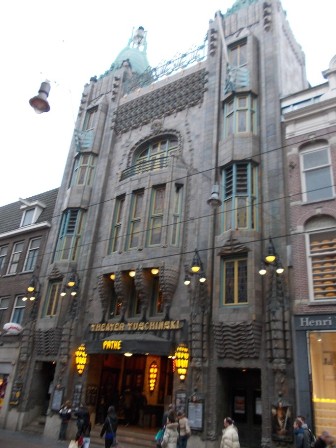Abraham Tuschinski and his dream Abraham Icek Tuschinski was only 17 years old when in 1903, fleeing the pogrom, he left his native Poland for America. He temporarily stopped in Rotterdam, waiting for further transport, and then he decided to stay right there and try to realize his dreams in the Netherlands, which is the closest thing to America that can be found on the old continent anyway.
Movies, at that time, were a new popular passion and Tuschinski made clever use of it. When he was 25 years old, he already opened his first four cinemas in Rotterdam and later, in that city, at least one more, bigger and more beautiful than the others. The successful operation of those cinemas brought him enviable wealth and shyly opened the door to the social stratum he aspired to, the stratum of educated and classy members of the high class.
When Abraham Tuschinski was financially ready for it, he decided to realize his biggest dream: to create the best and most beautiful cinema in the world. He bought a plot in the center of Amsterdam, near Rembrandt Square, on Reguliersbreestraat, in a place also known as Duvelshoek – Devil’s Corner.
To develop the project, he hired the expert, but not too well-known, architect Hijman Louis de Jong, to whom he would often give design instructions himself, meddling, without complexes, even in the narrowest profession. Thus, in the period 1918-1921, a compromise building emerged, the result of alternating periods of cooperation and quarrels between a seasoned architect and a rich cinema magnate. Wanting to capture the spirit of the times and the taste of the audience, they created a building that we interpret today as a controversial mix of several architectural styles:
Art Nouveau, a style that had already been abandoned,
Art Deco, a style that had not yet been formed,
Amsterdam schools, style for buildings of other uses,
and the most important style:
Mr. Tuschinski’s personal taste.
Simplified, it can still be said that it is primarily an Art Deco building, one of the first of its kind in the world.
Forerunner of Art Deco
In the time after the World War, order began to return to architecture. Asymmetric facades, curved windows, rounded walls, ceramic creepers, lizards and peacocks on the facades, enchanting features of Art Nouveau, remained in the past and architecture returned to its earthly roots. The basic direction led to the complete predominance of function, elimination of decoration, pronounced construction in clear verticals and horizontals, and it eventually became the “international style”, which, in its final form, won the hearts of a wide audience and professional public.
But some who pursued such ideas stopped halfway. They wanted functionality, cleanliness and order, but they regretted the decoration. Admittedly, the facades have become symmetrical again, the construction is clear in principle, but not visible, the decoration is more modest and stylistically reduced, often limited to only one part of the facade, which is designated for it. Instead of playful motifs with flowers, leaves, creepers, reptiles and birds, extremely stylized motifs, sometimes purely geometric, became current, a remnant of late Cubism.
If we emphasize the essential similarity of Art Nouveau buildings with theater posters by Alfonso Mucha, and international style buildings with paintings by Malevich and Mondrian, then Art Deco buildings are analogous to Batman comics. The buildings built in this way were, at best, simply ignored by the decent, highly aestheticized elite, who did not consider this approach to architecture worthy of a name at all.
But what is kitsch for one generation is style for the next. Everything that you think you don’t like about today’s buildings and that annoys you, the next generation will declare as an authentic style, give it a name, specify its characteristics, interpret the influences and describe them in high-profile dissertations. Thus, Art Deco was recognized as an authentic style only in the 1960s, when it was called by that name for the first time, apparently in an English magazine. Objects in the Art Deco style are considered today to be irresistibly retro, to exude faith in the future, to be beautiful in their naivety, and to be valuable cultural monuments.

Theater Tuschinski in Amsterdam, the forerunner of that style, was no exception, so the artistic view of it went through the entire described cycle. It was a painful process. Already during construction, the architect himself could no longer endure constant aesthetic conflicts with the investor. After a series of arguments, he was finally fired, so two other architects were hired for the interior design: Pieter de Besten and Jaap Gidding. When the cinema was finished and the ceramic facade, in a style that does not have its own name, dawned on the street Reguliersbreestraat, the professional architectural public was unanimous and sent the building negative, strong, and even insulting criticism.
Theater Tuschinski
But, alas, the audience was delighted… The entrance foyer was designed and lit in such a way that it directly introduces you to the world of the unreal. On the walls were rich wallpaper, decorations made of dark, exotic wood, ceramics and bronze. A labyrinth of corridors led to several halls. There was a cabaret in one hall, a Japanese tea room in another, and a Moroccan interior in the third. But the big hall was a real spectacle. It looked like a ceremonial hall of some European national opera with two levels of balconies and 1200 seats. The innovative air conditioning and ventilation system provided equal thermal conditions in all parts of the hall. The sound of the theater organ of the leading American manufacturer Wurlitzer accompanied the then still silent films. In addition, an orchestra with 16 instruments was constantly employed and the hall was often used for live concerts by the world’s most famous musicians. During the renovation in 1936, a luxurious, brightly colored wool carpet, 5 cm deep, woven in Morocco, was placed on the floor. Fifty years later it was replaced by the same one, also Moroccan, which is still there today.

During the German occupation, the cinema was called the Tivoli, as Tuschinski was an obvious Jewish surname. For the next few years, only German films were shown there, so the Amsterdam audience boycotted their favorite cinema, turning to the theater, where they could at least see their own actors and listen to their own language.
Abraham Tuschinski, as a member of the wrong people, was arrested and deported to Poland, the gloomy country of his birth, from which he tried to escape forever as a young man. When he was killed in Auschwitz, on September 17, 1942, his entire life cycle closed over him in a gruesome way. He didn’t run away from anywhere, he didn’t run away from anything.
Two years later, his best enemy, the architect Hijman Louis de Jong, a rival in the Battle of Devil’s Corner, a rival from the time when, on the same building, they both built each of their masterpieces and did not even know that they were killed, was also killed in Auschwitz. their heated arguments the best thing they ever had in their lives.
After the war, the cinema regained its glory and today shines with its greatest brilliance. It traditionally hosts all major Dutch film premieres. On such occasions, the red carpet is spread over the entrance staircase and the sidewalk, so that the world’s great acting stars will step over it to an even more luxurious, more festive, Moroccan carpet in the Amsterdam Temple of Illusions.
The cinema was thoroughly reconstructed in the period 1998-2002, it was expanded, and now it has 6 halls, but for the original impression you should go to the big hall where, in addition to ordinary seats, there are also special love seats for two and special private boxes where the spectators are served cheeses and wine. The Moroccan lounge and Japanese tea room are still there, more beautiful than ever.
What do the citizens of Amsterdam, who grow up surrounded by the works of Rembrandt, Vermeer and van Gogh, think today about the artistic and architectural values of this cinema? Amsterdammers, as we all know, are pragmatic, free-spirited people, tolerate easy drugs, respect the beauties under the “red lights” and go to their favorite cinema, above all to enjoy life unencumbered. After all, today you will pay more to enter the Theater Tuschinski to see James Bond than to the Rijksmuseum to see Rembrandt, Vermeer and Frans Hals together.

